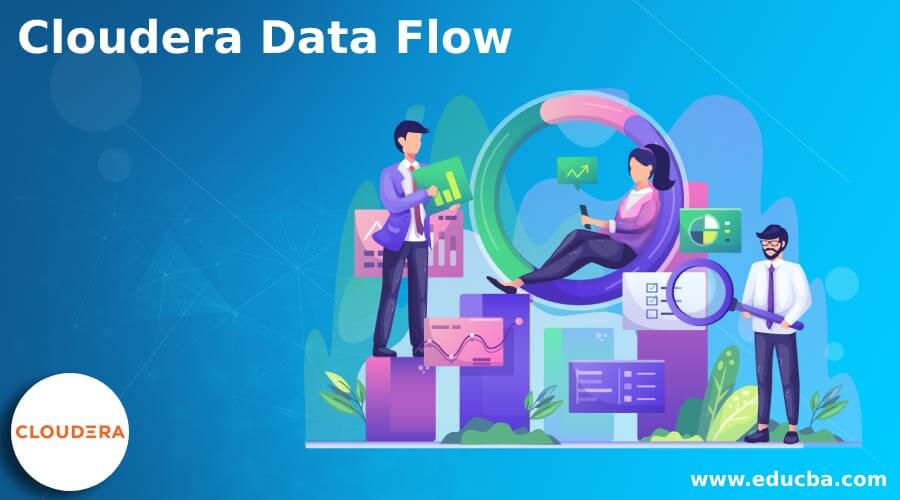Updated March 16, 2023

Introduction to Cloudera Data Flow
Cloudera Data Flow is CDP’s Public Cloud Service, formerly known as Hortonworks Data Flow, which is a scalable, real-time streaming analytic data platform that helps ingest, analyze, and curate the data for critical insights and immediate actionable intelligence. It enables self-serve deployments for Apache NiFi data flow to auto-scale Kubernetes clusters that Cloudera Data Platform manages. Cloudera Data Flow eliminates the operational overhead associated with Apache NiFi clusters and allows users to focus entirely on data flow development and meet business SLAs.
Cloudera Data Flow Platform
Cloudera Data Platform capabilities are available with CDP Public Cloud in two of the options mentioned below:
1. Data Flow for Data Hub
- Deployment of Flow Management, Stream processing clusters with CDP is accessed through a simple Data Hub Service that minutes in the cloud and eliminates complex, time-consuming infrastructure management and planning.
- It simplifies data collection with streaming easy-to-use cloud services available on Azure, Google Cloud Platform, and AWS.
- Data Flow for Data Hub also delivers the innovation and power, enterprise security, and scaling of Kafka, Apache NiFi, and Flink with consistent security and governance across the hybrid and public clouds.
2. Data Flow for Public Cloud
- Data Flow for Public Cloud addresses challenges like underestimating cluster size and unplanned infrastructure expense.
- It is scaling up infrastructure on an as-needed basis that can be an operational nightmare.
- Sharing the resources among multiple NiFi flows in the same clusters impacts overall performance.
- Monitoring the metrics of data flow in a single view for multiple clusters isn’t possible with the current tool.
Applications of Cloudera Data Flow
Cloudera Data Flow accelerates time by enabling off-shelf and flow-based programming for big data infra in a security-rich environment. CDF is designed to simplify the current complexity of secure data acquisition, real-time analysis, and ingestion of distributed and disparate data sources.
- Edge & Flow Management: It manages, controls, and monitors edges for streaming IoT initiatives and delivering real-time stream data with no code ingestion and management.
- Streams Messaging: It buffers and scales a massive volume of data ingestion to serve the real-time data needs of cloud and enterprise applications.
- Stream Processing and Analytics: It empowers real-time insights to improve response and detect critical events that can deliver valuable business outcomes.
- Flow Management: It offers a simple visual UI to build sophisticated data transformation, ingestion, and enrichment requirements across various streaming data targets and sources. It enables users to ingest stream data from devices, partner systems, enterprise applications, and cloud applications at 1 billion events/ second.
- Stream Messaging: It enables enterprises to ingest, scale, and buffer a massive volume of real-time data to servers on cloud and on-premise applications. It is powered by Apache Kafka, a stream messaging capability that enables real-time access to various applications.
- Streaming Analytics: It employs the latest gen low latency stream processing and analytic engine that addresses real-time insights and requirements for predictive analysis. Apache Flink powers streaming analytics, which helps to democratize streaming analytics around enterprises to deliver business outcomes.
Examples of Cloudera Data Flow
Given below are the examples mentioned:
Example #1
Internet of Things (IoT)
Cloudera Data Flow is a scalable platform for ingestion and acquiring IoT, broadly known as IoA, i.e., Internet of Anything.
- Secure Data Collection: Cloudera Data Flow addresses the security needs of IoT with reliable, security-rich, and integrated extensive data collection designed with simplicity. Security features include end-to-end protection and chain of custody for the data. In addition, it enables the IoT system to verify the origins of data flow, troubleshoot from origin point to destination and determine the data sources.
- Adaptive to Resource Constraints: Data sources may be remote, and physical footprints will be limited; bandwidth and power will likely be both constrained and variable. It supports prioritization within a data flow. Bidirectional data flow adapts to data volume fluctuations, network connectivity, endpoint, and source capacity. It holds less critical data for future transmissions.
Example #2
Accelerated data collection and operational effectiveness.
Big data collection and ingestion tools are purpose-built and over-engineered as they weren’t created with operationally efficient and universally applicable design principles. This completes a complex messaging architecture, disparate acquisition, and customized transformation tools, making operations time-consuming and expensive—the process results in faster ROI return of big data projects and increased operational effectiveness.
Example #3
Increased security and robust chain of custody
Tools used for transporting electronic data are not designed for future security requirements. It is difficult for present tools to share the discrete bits of data.
- Increased Security and Provenance with Cloudera Data Flow: It provides end-to-end data history. The ability to meet compliance regulations and data origin offers a method for tracking the data from the point of origin and from virtually any point in the data flow in determining which data sources are mainly used and the most valuable.
Conclusion
We have seen what Cloudera Data Flow means and its CDF Platform overview consisting of two capabilities, i.e., Data Flow for Data Hub and Data Flow for Public Cloud. We have also gone through the Data Flow applications of each Data Hub and Public Cloud. Finally, I have listed a few of Cloudera’s Data Flow applications.
Recommended Articles
This is a guide to Cloudera Data Flow. Here we discuss the introduction, Cloudera data flow platform, applications, and examples. You may also have a look at the following articles to learn more –

